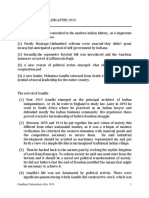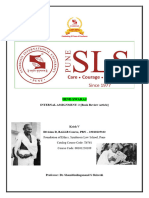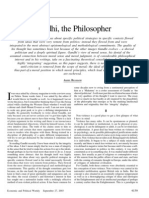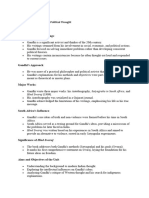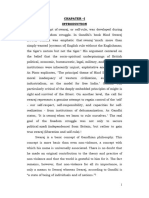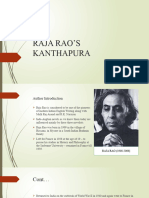Gandhi and Mass Mobilization
Gandhi and Mass Mobilization
Uploaded by
Riya VermaCopyright:
Available Formats
Gandhi and Mass Mobilization
Gandhi and Mass Mobilization
Uploaded by
Riya VermaCopyright
Available Formats
Share this document
Did you find this document useful?
Is this content inappropriate?
Copyright:
Available Formats
Gandhi and Mass Mobilization
Gandhi and Mass Mobilization
Uploaded by
Riya VermaCopyright:
Available Formats
Download Delhi University Political Science Notes from TutorialsDuniya.
com
Discipline course - 1
Semester - 2
Paper – Nationalism in India
Lesson - Gandhi and Mass Mobilization
Lesson Developer: Jyoti Trehan Sharma
College /Department: Indraprastha College for Women,
University of Delhi, Delhi / Political Science
Download Delhi University Question Papers with Solutions from TutorialsDuniya.com
Download Delhi University Political Science Notes from TutorialsDuniya.com
CONTENTS
Introduction
Influences on Gandhi
Inspiration from Indian Sources
Gandhi’s Philosophy in Action
Gandhi and Hind Swaraj
Gandhi and the Masses
Notes and References
Bibliography
Exercises
Download Delhi University Question Papers with Solutions from TutorialsDuniya.com
Download Delhi University Political Science Notes from TutorialsDuniya.com
NATIONALISM IN INDIA
GANDHI AND MASS MOBILISATION
INTRODUCTION
The changing time have spoken innumerably about Gandhi as the interpreter of India to the outside world.
But on a closer view, it is more significant and equally true that he was actually the interpreter of India to
herself. He knew that the true heart of India resided not in her sophisticated and westernized Cities but in
her thousands of Villages, and it was to them that he addressed his Appeal, appease and argument. Without
doubt, it is recognized, that Gandhi controlled and led the Indian masses for almost three decades, and thus
transformed the Indian Society. His image of charismatic leader enjoyed boundless loyalty of the Indian
People. He himself believed that he was born to show people the better way. As he wrote, ‘God….. has
1
chosen me as his instrument for presenting non-violence to India……’ There are only a few leaders in
human history who have appealed to all sections of the diverse population as Gandhi did, as he could rise
above conflicts and envisage perfect harmony in the midst of diversity. He actually had a deep inside into
the mass psyche, and thus wanted the Indian people to rise morally, economically and spiritually. He
believed that it was moral degradation that had condemned them to political subjection. In an
unprecedented and unparalleled struggle, Gandhi transformed India’s weakness into a source of strength by
transmuting the inertia that had griped the Indian masses. India found in Gandhi a unique leader who had no
enemy and who created no enemy. He was totally committed to the people and depended on them for his
movements. He understood people and situations, and this became the hallmark of his leadership. He first
Download Delhi University Question Papers with Solutions from TutorialsDuniya.com
Download Delhi University Political Science Notes from TutorialsDuniya.com
ventured out to the masses and adopted techniques and varied from time to time and from situation to
situation. His techniques were not a presentation of his impersonal religious or moral course, but as a series
of his personal experiments with truth, for which he never claim either finality or universal validity. He
touched the mass mind so deeply that when he travelled from place to place wearing only a loincloth,
thousands of people ran to get a “darshan” of Gandhi. The alien imperialist only sought to ridicule Gandhi
2
as a “half-naked fakir”.
Judith Brown has described the nationalist movement in India before the arrival of Mohandas
Karamchand Gandhi, soon to be known as Mahatama Gandhi, from South Africa in 1915 as ‘politics of
studied limitations’. Ravinder Kumar described it as ‘a movement representing the classes’ as opposed to
3
the masses. Nationalist politics was addressed only by a limited group of western-educated professionals
and bourgeoisie, who were more concerned about creating a new elite society and cultural for themselves
and were influenced by the ideas and ideals of the British aristocracy or the middle classes. The imperialist
government took relief in the fact that the Congress was actually being run as a closed shop by a
‘microscopic minority’, and as limited in its ultimate goals. After the Surat split in 1907, the moderates
demanded colonial self-government, while the Extremists put forth their demand of complete
4
independence. A few historians opined that both these groups lost credibility as they failed to achieve their
stated goals. Gandhi, in his classic ‘Hind Swaraj’, referred to them as the ‘slow party’ and the ‘impatient
5
party’ respectively and believed that the division was not a good thing for the Country. As centers of
extremism, namely Bengal, Maharashtra and Punjab, gradually began to witness the outbreak of terrorism,
the government got an opportunity to unleash repression. With Tilak in prison and moderate-dominated
Congress getting submerged in total inactivity, these were nothing much left to manoeuvre politically. The
ground was ripe for a fresher who was not a stained by the failure of these groups. Destiny inevitably
prepared the ground to shift power from the western-educated elites to the hands of the masses in an age of
political despondency and moral vacuum.
The First World War showcased the ugly face of the western civilization; a period that also greeted
Gandhi with his background of her successful encounter with the British in South Africa. Judith Brown has
Download Delhi University Question Papers with Solutions from TutorialsDuniya.com
Download Delhi University Political Science Notes from TutorialsDuniya.com
6
argued that Gandhi’s novel political ideology ‘appealed to few wholly, but to many partially’. But, what is
remarkable is, that everyone could find in it something to identify with. Truth, non-violence, self-scarifies,
self-abnegation, piece, tolerance, universal love, equality and liberty were the ingredients of his technique
and strategy. And he took utmost care not to alienate any of the Indian classes or community as he
considered them to be the construct of Indian pluralism. Religion had a stronger influence on the popular
mind, Gandhi believed and not the institution of class. Thus, began the era of the successful use of the
popular religious idioms that could mobilize the masses. India had entered the phase of religious morality.
7
Recognizing the diversity of India, Gandhian politics came to be identified as one of ‘Inclusivism’.
INFLUENCES ON GANDHI –
Various sources have been reasonably responsible for Gandhi to create his own set of political ideas. He
derived inspiration from the writings of Henry David Thoreau, John Ruskin, Ralph Waldo Emerson and
also Leo Tolstoy. Gandhi was greatly influenced by the words and deeds of Thoreau, the well-known
American anarchist who had refused to pay his taxes as a protest against slavery in the United States of
America. Thoreau was the first to use the term civil disobedience in one of his speeches in 1849. But
Gandhi did not derive his idea of civil disobedience from Thoreau’s writings. The resistance to authority in
South Africa was clearly well-advanced before he could get Thoreau’s ‘Essay on Civil Disobedience’. The
movement was then known as ‘passive resistence. Gandhi did begin to use Thoreau’s phrase to explain the
struggle, but he realized that even ‘civil disobedience’ could not convey the full meaning of struggle. So, he
adopted the phrase ‘civil resistance’. Gandhi liked the classical statement of Thoreau that ‘that government
8
is best which governs the least’.
The most characteristic example of the foreign influence on Gandhi was John Ruskin’s ‘Unto This
Last, that shaped his views. Gandhi was especially influenced by Ruskin’s ideal of manual labour, from
whose he drew three lessons:-
that the good of the individual is contained in the good of all.
Download Delhi University Question Papers with Solutions from TutorialsDuniya.com
Download Delhi University Political Science Notes from TutorialsDuniya.com
that a lawyer’s work has the same value as the barber’s in as much as all have the same right
of earning their livelihood from their work, and
that a life of labour, i.e., the life of the tiller of the soil and the handicraftsman, is the only life
9
worth living.
Gandhi read Emerson’s essays as he saw in Emerson’s essays, as he put it, ‘the teaching of the
Indian wisdom in a Western garb. These essays contained writings on history, self-reliance, spiritual
10
laws, heroism and art. Last, but not least, the influence of Leo Tolstoy on Gandhi has also been
widely recognized. Gandhi read ‘The Kingdom of God is within you’ for the first time in 1894, and he
recorded in his autobiography that he was extremely overwhelmed to read it. He was impressed by the
fact that through it Tolstoy presented Christianity as an ethical system, and not as a dogmatic one.
Gandhi found the Sermon on the Mount at the heart of Christianity, which, according to Tolstoy
teaches the doctrine of non-violence and the ultimacy of the conscience. It also reflects on the question
of violence in the world. This work of Tolstoy was a mandatory reading for the members of the
11
Phoenix Settlement, and later Gandhi had it translated in Gujarati.
INSPIRATION FROM INDIAN SOURCES –
Apart from the writings of Thoreau, Ruskin, Emerson and Tolstoy, Gandhi was equally influenced by
Jainism and Vaishnavism. It was this Indian philosophy and religiosity that enabled Gandhi to integrate
Western ideas into a coherent whole. He began to read the Indian philosophy texts in London, starting
with ‘The Song Celestial’, Sir Edwin Arnold’s translation of the Gita. Soon others followed, like ‘The
Light of Asia’, the biography of Buddha, also by Sir Edwin Arnold, ‘Life of Mahomet and his
Successors’ by Washington Irving, Carlyle’s life of the Prophet in ‘Heroes and Hero Worship’, and a
book of the Parsi religion, ‘The Sayings of Zarathustra’. But it was Raychandra Ravjibhai Mehta, a
Gujarati Jain mystic and diamond merchant, who guided Gandhi in the development of his though in
Indian philosophy. Raychandra is the one who also explained the meaning of the notion ‘Dharma’.
‘Dharma does not mean any particular creed or dogma. Nor does it mean reading or learning by rote
books knows as Shastras (sacred texts) or even believing all that they say. Rather, dharma is a quality
Download Delhi University Question Papers with Solutions from TutorialsDuniya.com
Download Delhi University Political Science Notes from TutorialsDuniya.com
of the soul present in every human being. Through it we know our duty in human life and our true
12
relation with other souls……….. dharma is the means by which we can know ourselves’.
However, despite Raychandra’s influence on Gandhi, he went much beyond the intellectual
horizons, and by the first decade of the 20th century, was focusing on the spiritual life, and more and
more on the ‘Bhagwad Gita’ and the ‘Ramayana’ of Tulsidas. Both these texts were theistic in
orientation. In his classic work ‘Hind Swaraj’, Gandhi quoted Tulsidas in Chapters 14 and 17, and the
technical definition of Swaraj as self-rule, understood as the rule of the mind over itself and the
passions, is derived from the Gita. Thus, the mind emerged principally as the key-faculty in Gandhi’s
13
political philosophy.
Gandhi’s approach to the Gita differs markedly from the method of many traditional
interpreters who expend great effort on textual interpretation and on establishing the internal logic of
the various theoretical statements and practical directives of the text. But in one important way
Gandhi’s approach is in close conformity with a major, traditional rule of interpretation. He identifies
the central, the key passage in the text; the mahavakya, “The great statement” that gives the central
message, in terms of which all the rest of the text must be explained. For Gandhi the last twenty stanzas
of chapter two constitute the Gita’s mahavakya in the description of the sthitaprajna. This passage in
fact expresses most succinctly, without any mythical, ritual, or dogmatic paraphernalia, without
“imagination,” the essence of religion as he saw it. His concept of the nature of the scripture was
largely inherited from Raychandra. Jainism, moreover, gave Gandhi the basic theoretical structure that
best fitted his own deepest nature, that of a “religious activist,” with its dualism of jiva-ajiva, spirit and
matter, its inexorable law of Karma, and its conception of the gradual purification of the Atman
14
necessary on the highroad to self-realization.
GANDHI’S PHILOSOPHY IN ACTION –
Gandhi professed a form of Hinduism, no doubt, but deviated so far from orthodoxy as to
equate God and Truth, as rationally perceived, and to emphasize the validity of all religious beliefs on
Download Delhi University Question Papers with Solutions from TutorialsDuniya.com
Download Delhi University Political Science Notes from TutorialsDuniya.com
the basis of their moral worth. Truth was the supreme value not only for Gandhi, but has been a key
concept in the Indian traditional ethico-religious thought. However, Gandhi accepted Truth not merely
as a concept, but sought to realize it in practice as the ‘sovereign principle’ of life and conduct, and as a
reality. And since God is also thought of as being the only Eternal Reality, He is, for Gandhi, the same
as Truth. The two have been essentially equated, for Gandhi found in Truth the quickest and the easiest
way to realize God. Gandhi made truth paramount. Nonetheless, in his search for Absolute Truth, he
was fully aware that the absolute cannot be known by the yet unfulfilled human mind.
In Gandhian philosophy, closely connected with the ultimate or absolute end was the problem
of means. Gandhi laid surpassing emphasis on the use of right means for achieving objectives. For him,
means and ends were convertible terms. The two were inseparable and should be equally pure. As
Gandhi himself said: “The means may be likened to a seed, the end to a tree; and there is just the same
15
inviolable connection between the means and the end as there is between the seed and the tree.”
Specifically speaking thus, non-violence as a means became the supreme value for Gandhi. Not only
this, but Gandhi’s interpretation of ahimsa (non-violence) is also striking for its unparalleled richness
of significance because, for Gandhi, it did not stand for pacifism, but as an inspiration for the
individual and the nation to achieve complete harmony with all the impulses of human nature.
However, the impression that one gets is that Gandhi believed in non-violence as creed, as an eternal
virtue and as a supreme way of life to which even the freedom of the country could be subordinated.
But still, a more careful analysis of his activities would betray a tendency on Gandhi’s part to equate
expediency with principle. The pain that he took to emphasize the extreme intimacy of the inter-
relation between truth and non-violence is a remarkable feature of Gandhi.
Another clear contribution of Gandhi is the way he practiced and understood fasting – as a
heightened moment in the practice of ahimsa. He used it, on the hand, to achieve social objectives and,
on the other, for the realization of his essential, identically with others. In fact, he illustrated how
fasting is being very close to God.
Gandhi also found a needful and continual self-expansion of every concept in the setting of
practice in his knitwork of vows, namely,
Download Delhi University Question Papers with Solutions from TutorialsDuniya.com
TutorialsDuniya.com
Download Delhi University Notes & Previous Year
Question Papers with Solutions from
TutorialsDuniya.com
General Electives AECC
B.Sc. (H) Computer Science B.Sc. (H) Mathematics
B.Sc. (H) Chemistry B.Sc. (H) Physics
B.Sc. (H) Electronics B.Sc. (H) Statistics
B.Sc. (H) Botany B.Sc. (H) Geology
B.Sc. (H) Home Science B.Sc. (H) Zoology
B.Com (H) B.Sc. (H) Microbiology
B.Sc. Physical Science B.Sc. Mathematical Science
B.A. Programme BMS
B.A. (H) Psychology B.Sc. Life Science
B.A. (H) Economics B.A. (H) English
B.A. (H) Hindi B.A. (H) History
B.A. (H) Journalism B.A. (H) Philosophy
B.A. (H) Political Science B.A. (H) Geography
B.A. (H) Sanskrit B.A. (H) Sociology
Please Share these Question Papers with your Friends
Download Delhi University Political Science Notes from TutorialsDuniya.com
(i) Brahmacharya: This is not isolated control of sex, but simultaneous control of all the senses.
And in the practice of brahmacharya, Gandhi stressed the role of will, as against mere
instinctual thoughts. It ought to be observed in thought, word and deed.
(ii) Asvada: Though it is not merely bodily in significance, brahmacharya vitally depends on the
control of the palate. Gandhi, therefore, turned asvada into a distinctive vow, thus enriching
the Hindu ethical tradition.
(iii) Asteya: Though asteya literally means not to commit theft, Gandhi interpreted it in a far
subtler way. He described the essence of non-stealing as stealth (or the tendency to conceal)
and not mere abstention from theft of others’ property. Like asvada, asteya has a positive
significance. It calls for definite effort to abstain from conditions which bar the manifestation
of truth.
(iv) Aparigraha: Though the literal meaning of aparigraha is not to possess property; it has (like
asvada and asteya) a distinct positive significance in Gandhian thought. Gandhi’s treatment of
this vow is the idea that aparigraha requires one to be non-attached even to the body which
too is a kind of possession. Gandhi believed that if one looks upon the body merely as an
instrument of service, one can attain real happiness and the beatific vision in the fullness of
time.
(v) Abhaya: Following the Gita, Gandhi gave the place of pre-eminence to the observance of
abhaya or fearlessness. He regarded this vow as indispensable for the growth of other noble
qualities. Nonetheless, instead of extolling fearlessness categorically, Gandhi cared to say that
one does not need to fear the inner foes.
(vi) Apart from the above vows, Gandhi also insisted on the four distinctive vows of Removal of
Untouchability, Principle of Bread-labour (fruits of labour accrue only to him who has worked
16
for it), Sarvadharma Samabhava (equal respect for all religions) and Swadeshi.
Ethical religion brought about a distinctiveness in Gandhi. Gandhi did not accept the orthodox
interpretation of religion though he employed the concept to convey his own philosophy, but like the
Download Delhi University Question Papers with Solutions from TutorialsDuniya.com
Download Delhi University Political Science Notes from TutorialsDuniya.com
Buddhists, he taught a universalized religion on ahimsa. He also interpreted religion or dharma, as
selfless service of others, mastery over passions fearlessness and most important of all, devotion.
Accordingly, dharma, for Gandhi, became an embodiment of the content that was shaped by one’s own
special gifts, the discipline a man voluntarily undertakes, and a moral insight which leads a man
beyond the performance of his customary duties.
In his description of dharma, one of the main things Gandhi emphasized was that caste had
nothing to do with religion. It was a later excrescence on what had originally been basically the
principle of labour and of duties. What remained was an outstanding feature of the Hindu social
system, but this should in no way be confused with religion, with dharma, with the life it was good and
reasonable for men to lead. Gandhi realized that the caste system was opposed both to his principle of
universal ahimsa and his programme to abolish untouchability. He demanded the abolition of caste as
unjust and immoral, and the substitution of a non-religiously-sanctioned occupational, but hereditary
17
class structure.
Gandhi turned the tables on Swami Vivekananda’s formula that all men should be brahmins,
by saying that all should be sudras. Sudras are those who serve, and nothing more was needed than
service, whether in Indian society or elsewhere. Gandhi thus, attempted to incorporate the duties of
scavenging and bread labour in the concept of dharma. He tried working out his ideas in a society
where dirty work was the lot of the untouchables, the outcastes of the Hindu society, and where manual
work was considered inferior to the work of the scholar, lawyer and teacher. Thus, Tolstoy’s
therapeutic value of manual work and Ruskin’s views on the equal value of different kinds of work to
society became the basis of Gandhi’s thought that trusted for the good of society.
Gandhi interpreted his own life as being guided by the dharmas of social service, poverty,
harmlessness, vegetarianism and celibacy, whose practical applications, were, for him, no more than
mere experiments with truth. As he himself said: “The instruments for the quest of truth are as simple
as they are difficult. They may appear quite impossible to an arrogant person, and quite possible to an
innocent child. The seeker after truth should be humbler that the dust. The world crushes the dust under
its feet, but the seeker after truth should be so humble himself that even the dust could crush him. Only
18
then, and not till then, will he have a glimpse of truth.” However, what has been unique in Gandhi’s
Download Delhi University Question Papers with Solutions from TutorialsDuniya.com
Download Delhi University Political Science Notes from TutorialsDuniya.com
experiments with Truth was that they were carried out not in the seclusion of an ashrama, but in the
arena of life. And when the scene shifted to the political front, religion became a means of mass-
mobilization.
Gandhi considered his own philosophical system superior to the Hindu art of politics. He
endeavoured to develop a sense of unity by employing traditional terms, but was far more successful in
communicating to the masses through his personality and ways of life, appearing as he did as a modern
sanyasi, and this traditional appearance especially influenced the Indian women, chiefly devotees of
Bhakti worship.
The combination of religion with politics or religious politics is the very essence of Gandhism,
and on its legitimacy or otherwise depends the whole significance of the fact of Gandhi. Gandhi
himself asserted: “Yes, I still hold the view that I cannot conceive politics as divorced from religion.
Indeed religion should pervade every one of our actions. For me there is no politics without religion not
the religion of the superstitious and the blind, religion that hates and fights, but the universal religion of
19
toleration. Politics without morality is a thing to be avoided.” Here Gandhi claimed to be in stark
contrast of Machiavelli’s concept of complete separation of religion and politics.
That, Gandhi was opposed to Machiavellian approach to politics seems plausible. His
exhortations with regard to the restoration of moral values in political practice might appear utopian in
the present context when politics has gone downhill. But for him, it was a practical proposition. His
periodic reference to conscience in dealing with decision-making in day-to-day functioning was an
indication of his faith in the corrigibility of man. That is why, Gandhi was disturbed by the emergence
of religious intolerance, communal frenzy and the like, which marred peace and harmony in society.
Gandhi repeatedly asserted the oneness of life. It was one continuous whole and could not
properly be conceived as compartmental. Therefore, it was not a matter of “mixing” religion and
politics, for they were already rightfully one. However, there is a probability that Gandhi himself
experienced a dichotomy between his religious pursuits and political endeavours, which was never
completely resolved. But in spite of such a tension, he succeeded in evolving a well-integrated
personality, especially religiously-oriented.
Gandhi felt that spiritual values had no relevance unless they were put into social practice by
those who professed them. As such, it was not very difficult for a semi-clad contemplative sanyasi to
Download Delhi University Question Papers with Solutions from TutorialsDuniya.com
Download Delhi University Political Science Notes from TutorialsDuniya.com
become a karma-yogi in the field of politics. Gandhi’s actions may also be justified in the sense that in
the Hindu tradition, religion is such an integrative force that there is bound to be a close relationship
between religion and politics. It can also be said that historically, culture, politics and religion have
been synonymous with Hinduism. One may recall that both Gautama Buddha and Mahavira, founders
respectively of Buddhism and Jainism, were of the ruling or warrior caste. Part of the shastras are
political texts, such as the Arthasastra attributed to Kautilya and parts of the Laws of Manu.
Nevertheless, tension was not entirely absent between religion and politics, for the latter often took a
20
ruthless turn and, thereby stimulated transcendental speculation in Indian religious life.
Gandhi’s religious quest helped him to mould not only his personality, but the political
technique with which he confronted racialism in South Africa and colonialism in India. Gandhi
inherited Swaraj as the political objective of the Congress; however, he felt compelled to find a moral
issue upon which to base his campaigns of political agitation, and he finally succeeded in being able to
rationalize that, while Swaraj was not a self-justifying objective in the traditionalist sense, the
immortality of the British Raj made Indian Swaraj a morally justifiable goal.
Gandhi felt that, in India, the masses had no political consciousness. Their politics was
confined to bread and salt and to communal adjustments. Therefore, he wanted that the politicians must
represent the masses in opposition to government. “But if we begin to use them before they are ready
21
we shall cease to represent them.” And for this, he stressed the necessity of using the imagination
when making moral decisions. To be capable of moral judgement and moral conduct on a significant
scale, one has necessarily to put oneself in the place of other people and imagine sympathetically how
they feel. Gandhi recognized no God except the God that is found in the hearts of the “dumb millions”.
Anything that millions can do together is, he believed, charged with a unique power, the magical
22
potency of collective taps or moral fervour, the cumulative strength of generally shared sacrifices.
GANDHI AND HIND SWARAJ –
In Hind Swaraj (1909), Gandhi offered a civilizational concept of the Indian nation.
According to him, the Indians constituted a nation or ‘praja’; and the ideal of swaraj could only be
achieved in the modern times in a United Indian nation or praja. Swaraj and home rule must meet in a
Download Delhi University Question Papers with Solutions from TutorialsDuniya.com
Download Delhi University Political Science Notes from TutorialsDuniya.com
newly constituted Indian praja. Gandhi’s philosophy differed significantly from the earlier nationalists
in as much as that he began with a trenchant critique of the ‘modern’ civilization. He roared, ‘The
23
English have not taken India; we have given it to them’. Gandhi proclaimed that Indians themselves
were responsible for their enslavement, as they embraced capitalism and its associated legal and
political structures. By offering an ideological critique of the Western civilization, Gandhi effectively
contested the moral legitimacy of the British rule that rested on a stated assumption of the superiority
of the West. In the process, the application of his methods gave him immense maneuverability in terms
of real politics, sometimes on the grounds of non-violence while, at other time, on the issue of means
and ends. Gandhi, thus, throughout his life, remained a negotiator. He began constructing those broad
roads whose map was already drawn by Tilak in Maharashtra in the 1890’s, by the activities of the
Punjab extremists, and above all, the Swadeshi movement in Bengal in 1905-08. Annie Besant and
Tilak prepared the ground for the success of Gandhi’s initial satyagraha movement and mass
mobilization. Gandhi had arrived.
GANDHI AND THE MASSES –
In a political space that was clearly divided between the Moderates and the extremists, Gandhi
took a very safe centrist position, and succeeded in uniting both of them on a common political
platform. He adopted the moderates’ goal of Swaraj, but his method of satyagraha looked very much
24
like the passive resistance of the extremists. However, his insistence on non-violence always made
the moderates apprehensive. But beyond the ranks of nationalist politics and leadership, Gandhi was
capacitated to create an appeal amongst the masses and unleash their vast reservoir of energy. Judith
Brown has, however, argued that Gandhi’s rise did not symbolize a radical restructuring of political life
or opening of modern politics to the masses: rather it signified the rise of Western-educated and
regional language literate elites of backward areas, in place of the Western-educated leaders of the
presidency towns. It was the loyalty networks of these local elite leaders, or the so-called “sub-
contractors”, which mobilized popular support for Gandhi in the Indian Country-side and small
25
towns.
It would be grossly unfair to underestimate Gandhi through these interpretations. His persona
rested on a popular appeal that emerged sometimes out of his simple attire, while, at other times,
through his reference to the popular allegory of the Ramrajya. His charisma arose out of the skillful use
Download Delhi University Question Papers with Solutions from TutorialsDuniya.com
Download Delhi University Political Science Notes from TutorialsDuniya.com
of religious idioms and symbols, Masses began to believe he was a healer, and soon became a symbol
of power for the powerless. He was the Messiah. He prescribed a path, and they walked behind him.
Many times, they deviated from his path, but soon returned to his fold and his hold. It was the era of
the Mythical Mysticism of the Mahatma, the great Soul.
Gandhi entered into a world of politics that created many occasions for his transition from local to
national leadership. His personality, his novel approach to politics and his new techniques of struggle
gave him an access to power, enabling him to become the focus of multifarious local grievances. From
getting involved in fighting the local wrongs at Champaran, Kheda and Ahmedabad, in no time,
Gandhi reinforced his claim to the all – India leadership by his decision to champion the Khilafat issue
and seek redress of the Punjab wrongs, from locals to peasantry, to industrial workers, and then to the
Muslim support, Gandhi became a symbol of mass-mobilisation. Namboodiripad, in his work ‘The
Mahatma and the Ism’, summed up that it was a combination of three factors, namely,
- His independent organization of a band of satyagrahis around himself,
- His successful affiliation with the living political issues that were uppermost in the minds of the
people, and
- His reliance on the Muslim divines on the issue of Khilafat,
enabled Gandhi to assume the reigns of all – India leadership and emerge as the undisputed leader of
the masses. His style claimed a new status in politics – a style that could not be ignored but was
26
difficult to comprehend.
Gandhi worked as if under a compelling sense of urgency. He declared, ‘I am impatient to
break the British bondage’. It was under this sense of urgency that he said in 1920, ‘Swaraj in one
year’, and in 1930, ‘now or never’. Even the previous failures did not deter him from raising the slogan
‘do or die’ in 1942. It was this sense of urgency that made him swear not to return to his ashram alive
until India got freedom. He could also be ruthless at times if he found this to be necessary for his
mission, as in the case of boycott of foreign cloth. He advised the nation to burn cloth. He challenged
the mightiest empire of the world with no weapon available to him except non-violent non -
27
cooperation. Actually, Gandhi sought to transform India’s weakness itself into a source of strength
by transmuting the inertia and inaction which had gripped the masses. He broke the barrier of fear in
the minds of the people. At times, he also admitted to have committed blunders by offering the weapon
Download Delhi University Question Papers with Solutions from TutorialsDuniya.com
Download Delhi University Political Science Notes from TutorialsDuniya.com
of satyagraha without sufficiently training them, but the hallmark of Gandhian politics is that it
transformed Indian nationalist politics from being the politics of restricted classes to becoming politics
of the masses.
NOTES AND REFERENCES
1. Harijan (Ahmedabad), 23 July, 1938, p. 193
2. M.M. Verma, Gandhi’s Technique of Mass Mobilisation R.K. Gupta & Co., New Delhi, 1990, p.8
3. Sekhar Bandyopadhyay, From Plassey to Partition: A History of Modern India, Orient Black Swan, New
Delhi, 2010, p.284.
4. Ibid., p.285
5. Anthony J. Parel (ed.), Hind Swaraj and other writings, Combridge University Press, New Delhi, 2004,
p. 23.
6.
Sekhar Bandyopadhyay, p.288.
7. Ibid
8. M.M. Verma, p.70.
9. Ibid., p.71
10. Anthony Parel, p. xivi
11. Ibid., p xxxvii
12. Ibid., p. xiix
Download Delhi University Question Papers with Solutions from TutorialsDuniya.com
Download Delhi University Political Science Notes from TutorialsDuniya.com
13. Ibid., p. l.
14. Jyoti Sharma, Tilak and Gandhi: Perspectives on Religion and Politics, Gyan Publishing House, New
Delhi, 200, p.177.
15. M.K.Gandhi, Hind Swaraj or Indian Home Rule, G.A. Natesan and Co.,Madras, 1909, p.60.
16. Jyoti Sharma, p.180.
17. Ibid.
18. M.K.Gandhi, An Autobiography or The Story of My Experiments with Truths, Navjivan Publishing
House, Ahmedabad,1927, p.xi – xii.
19. M.K.Gandhi, Insearch of the Supreme, Navjivan Publishing House, Ahmedabad, 1961, vol. II, p.308.
20. Jyoti Sharma, p.183.
21. Young India, Ahmedabad, September 1924.
22. Raghavan N. Iyer, The Moral and Political Thought of Matama Gandhi, OUP, New York, 1973, p.16 –
17.
23. Sekhar Bandyopadhyay, p.289.
24. Ibid., p.292.
25. Ibid
26. M.M.Verma, p,19.
27. Ibid, p.20.
Download Delhi University Question Papers with Solutions from TutorialsDuniya.com
Download Delhi University Political Science Notes from TutorialsDuniya.com
BIBLIOGRAPHY
1. Anthony J. Parel (ed.), Hind Swaraj and other writings, Combridge University Press, New Delhi, 2004
2. Harijan (Ahmedabad), 23 July, 1938
3. Jyoti Sharma, Tilak and Gandhi: Perspectives on Religion and Politics, Gyan Publishing House, New
Delhi, 2000.
4. M.K.Gandhi, Hind Swaraj or Indian Home Rule, G.A. Natesan and Co.,Madras, 1909.
5. M.K.Gandhi, An Autobiography or The Story of My Experiments with Truths, Navjivan Publishing
House, Ahmedabad,1927.
6. M.K.Gandhi, Insearch of the Supreme, Navjivan Publishing House, Ahmedabad, 1961, vol. II.
7. M.M. Verma, Gandhi’s Technique of Mass Mobilisation R.K. Gupta & Co., New Delhi, 1990
8. Raghavan N. Iyer, The Moral and Political Thought of Matama Gandhi, OUP, New York, 1973.
9. Sekhar Bandyopadhyay, From Plassey to Partition: A History of Modern India, Orient Black Swan, New
Delhi, 2010
10. Young India, Ahmedabad, September 1924.
Download Delhi University Question Papers with Solutions from TutorialsDuniya.com
Download Delhi University Political Science Notes from TutorialsDuniya.com
EXERCISES
Ques.1. Do you think Gandhi was a mass leader? Give reasons for your
answer.
Ques.2. What has been Gandhi’s approach in preparing the masses for
Satyagraha movements?
Ques.3. What have been the various influences on Gandhi’s life that shaped his
personality and prepared him to become a leader of the masses?
Download Delhi University Question Papers with Solutions from TutorialsDuniya.com
TutorialsDuniya.com
Download Delhi University Notes & Previous Year
Question Papers with Solutions from
TutorialsDuniya.com
General Electives AECC
B.Sc. (H) Computer Science B.Sc. (H) Mathematics
B.Sc. (H) Chemistry B.Sc. (H) Physics
B.Sc. (H) Electronics B.Sc. (H) Statistics
B.Sc. (H) Botany B.Sc. (H) Geology
B.Sc. (H) Home Science B.Sc. (H) Zoology
B.Com (H) B.Sc. (H) Microbiology
B.Sc. Physical Science B.Sc. Mathematical Science
B.A. Programme BMS
B.A. (H) Psychology B.Sc. Life Science
B.A. (H) Economics B.A. (H) English
B.A. (H) Hindi B.A. (H) History
B.A. (H) Journalism B.A. (H) Philosophy
B.A. (H) Political Science B.A. (H) Geography
B.A. (H) Sanskrit B.A. (H) Sociology
Please Share these Question Papers with your Friends
You might also like
- Goyal, O P - Studies in Modern Indian Political Thought The Moderates and The ExtrDocument124 pagesGoyal, O P - Studies in Modern Indian Political Thought The Moderates and The Extrselimreza_862998017No ratings yet
- Puja SankalpamDocument1 pagePuja SankalpamSunita DhanalakotaNo ratings yet
- Gandhi and Mass MobilizationDocument18 pagesGandhi and Mass MobilizationVijay ShreeNo ratings yet
- Hind Swaraj ReviewDocument4 pagesHind Swaraj Reviewyogendra choukiker0% (1)
- Gandhi AssignmentDocument8 pagesGandhi Assignmentzeba abbasNo ratings yet
- IJIRMF202207011Document4 pagesIJIRMF202207011Farha AijazNo ratings yet
- Gandhian NationalismDocument31 pagesGandhian NationalismMihir KeshariNo ratings yet
- Term Paper On GandhiDocument8 pagesTerm Paper On Gandhiea793wsz100% (1)
- Gandhi's Political ThoughtDocument160 pagesGandhi's Political Thoughtmaxtorrent100% (1)
- FF - Chapter 1Document47 pagesFF - Chapter 1nazmulNo ratings yet
- Gandhian Ideology: Chapter ThreeDocument67 pagesGandhian Ideology: Chapter ThreeAnmolNo ratings yet
- SLM - Comple-Modern Indian History (1857 To The Present) - II - III&IV Sem (His4 (3) c01) 19306Document178 pagesSLM - Comple-Modern Indian History (1857 To The Present) - II - III&IV Sem (His4 (3) c01) 19306NYX᭄FF YTNo ratings yet
- Ethics - IIDocument6 pagesEthics - IIkrish vikramNo ratings yet
- Vaibhav Civil PresentationDocument5 pagesVaibhav Civil PresentationAmitesh SinghNo ratings yet
- Gandhi's PhilosophyDocument5 pagesGandhi's Philosophyudaywal.nandiniNo ratings yet
- Gandhi Part 1Document25 pagesGandhi Part 1marissamoluNo ratings yet
- Mahatma Gandhi-1Document17 pagesMahatma Gandhi-1Aneet PaddaNo ratings yet
- Indian National Movement GANDHIAN PHASE (1917-1947) : Modern Indian History (1857 To The Present)Document77 pagesIndian National Movement GANDHIAN PHASE (1917-1947) : Modern Indian History (1857 To The Present)Parth PandeyNo ratings yet
- 05 - Chpter 1Document18 pages05 - Chpter 1yogeshNo ratings yet
- Gandhi Research Paper ThesisDocument8 pagesGandhi Research Paper Thesisdwns3cx2100% (1)
- Generic Elective (Political Science) Gandhi and The Contemporary World Study Material: Unit I-IVDocument110 pagesGeneric Elective (Political Science) Gandhi and The Contemporary World Study Material: Unit I-IVSakshi SinhaNo ratings yet
- GANDHIDocument21 pagesGANDHIMohit ThakurNo ratings yet
- Unit 4 BDocument10 pagesUnit 4 BR20PLP020 Kavya Reddy YNo ratings yet
- 03 - Review of LiteratureDocument9 pages03 - Review of LiteratureDinesh Soni0% (1)
- Political Science IDocument12 pagesPolitical Science IIsha PalNo ratings yet
- Central Idea of Mahatma Gandhi by LuisDocument4 pagesCentral Idea of Mahatma Gandhi by LuisANIKET MISHRA 103No ratings yet
- Leadership QualitiesDocument11 pagesLeadership QualitiesNirav RajyaguruNo ratings yet
- Foundation English Semester II 2021-2022Document94 pagesFoundation English Semester II 2021-2022Kavi KaviNo ratings yet
- Cardinal Theories and Political Thinkers of IndiaDocument11 pagesCardinal Theories and Political Thinkers of IndiaP Chakraborty100% (2)
- The Role of Mahatma Gandhi in The FreedoDocument8 pagesThe Role of Mahatma Gandhi in The Freedoporbotingti15No ratings yet
- Unit 10 Emergence of Gandhi: StructureDocument11 pagesUnit 10 Emergence of Gandhi: StructureAzimul Aktar Barbhuiya100% (1)
- Akeel Bilgrami - Gandhi - A Philosopher PDFDocument19 pagesAkeel Bilgrami - Gandhi - A Philosopher PDFaditya_2kNo ratings yet
- Manoj GandhiDocument23 pagesManoj GandhiQueenNo ratings yet
- Mahatma Gandhi Thesis StatementDocument7 pagesMahatma Gandhi Thesis StatementCollegePaperWritersStamford100% (2)
- Re-Reading Gandhi's Hind SwarajDocument5 pagesRe-Reading Gandhi's Hind SwarajPriti SehrawatNo ratings yet
- Unit 2Document9 pagesUnit 2Tanya PriyaNo ratings yet
- gandhianDocument14 pagesgandhianVansh TyagiNo ratings yet
- Political Science NotesDocument10 pagesPolitical Science NotesSonakshi SinhaNo ratings yet
- Comparative study of Mahatma Gandhi and Rabindranath Tagore's nationalismDocument4 pagesComparative study of Mahatma Gandhi and Rabindranath Tagore's nationalismgangesh8312No ratings yet
- The Best StoryDocument6 pagesThe Best StoryEslyium AvalonNo ratings yet
- Bhosale INDIANNATIONALISMGANDHI 2009Document10 pagesBhosale INDIANNATIONALISMGANDHI 2009Soumya VermaNo ratings yet
- Postmodern Gandhi and Other Essays: Gandhi in the World and at HomeFrom EverandPostmodern Gandhi and Other Essays: Gandhi in the World and at HomeNo ratings yet
- Gandhian Nationalism After 1919: Ideas and Movements: Institute of Lifelong Learning, University of DelhiDocument32 pagesGandhian Nationalism After 1919: Ideas and Movements: Institute of Lifelong Learning, University of DelhiRishali ChauhanNo ratings yet
- Bahi 13 Block 03Document65 pagesBahi 13 Block 03Dolamani MajhiNo ratings yet
- Bilgrami Gandhi The PhilosopherDocument7 pagesBilgrami Gandhi The PhilosopherJohnself2No ratings yet
- 01 Gandh The Man and His Times @nadalDocument189 pages01 Gandh The Man and His Times @nadalRamBabuMeenaNo ratings yet
- Notes MGP 4Document84 pagesNotes MGP 4mailyjain.21No ratings yet
- Maths ProjectDocument17 pagesMaths ProjectPrashanth KNo ratings yet
- Maharastra National Law University, Mumbai: M.K.GandhiDocument5 pagesMaharastra National Law University, Mumbai: M.K.GandhiNanda RajeshNo ratings yet
- GandhiDocument11 pagesGandhiAayat SyedNo ratings yet
- Gandhi Today: A Report on India's Gandhi Movement and Its Experiments in Nonviolence and Small Scale Alternatives (25th Anniversary Edition)From EverandGandhi Today: A Report on India's Gandhi Movement and Its Experiments in Nonviolence and Small Scale Alternatives (25th Anniversary Edition)No ratings yet
- 06 Chapter 1Document18 pages06 Chapter 1ksukriti16No ratings yet
- HIND SWARAJ Book ReviewDocument5 pagesHIND SWARAJ Book ReviewJennifer Maltos MartinaNo ratings yet
- Gandhi Essay ThesisDocument8 pagesGandhi Essay ThesisRichard Hogue100% (2)
- Mahatma GandhiDocument9 pagesMahatma Gandhiftdfg1346No ratings yet
- Call For Papers Concept NoteDocument3 pagesCall For Papers Concept NotenamitasinghNo ratings yet
- Gandhian SwarajDocument12 pagesGandhian SwarajTulsi TiwariNo ratings yet
- Unit-5 Gandhi IgnouDocument12 pagesUnit-5 Gandhi IgnouSanya SachdevaNo ratings yet
- Indian Express PDF 25 November 2020Document19 pagesIndian Express PDF 25 November 2020jayadevan vkNo ratings yet
- 28Document71 pages28RF AndyNo ratings yet
- The Conception of SamaraDocument8 pagesThe Conception of SamaraAn YênNo ratings yet
- RWS - VII - PA1 - History - 2024-25 (1) - 1Document4 pagesRWS - VII - PA1 - History - 2024-25 (1) - 1dashmesh.bhatia.123No ratings yet
- Devotee Jaidev Ji: Goojree Saree Jaidayv Jee-O Kaa Padaa Ghar 4Document4 pagesDevotee Jaidev Ji: Goojree Saree Jaidayv Jee-O Kaa Padaa Ghar 4Amardeep SinghNo ratings yet
- Visit: TirumalaDocument3 pagesVisit: TirumalaragavNo ratings yet
- Punjabi Language During British Rule Tariq RahmanDocument14 pagesPunjabi Language During British Rule Tariq RahmantanvirNo ratings yet
- SL - No Ward No Place of Damage Type of Road Lenth (Metre) Cost of Repair Per Metre Cost of RepairDocument1 pageSL - No Ward No Place of Damage Type of Road Lenth (Metre) Cost of Repair Per Metre Cost of RepairARUN SDNo ratings yet
- October Magazine Final ISSUEDocument12 pagesOctober Magazine Final ISSUEvaidyanathanNo ratings yet
- Medieval History Prelims NotesDocument19 pagesMedieval History Prelims Notesvinita thakur100% (1)
- Store BusinessesDocument660 pagesStore BusinessesShaurya RawatNo ratings yet
- Tagore Script For WomenDocument9 pagesTagore Script For WomenRiddhi JainNo ratings yet
- Meaning of Satyam Shivam SundaramDocument7 pagesMeaning of Satyam Shivam Sundaramrenato0% (1)
- Raja Rao's KanthapuraDocument25 pagesRaja Rao's Kanthapurarimasingha1975No ratings yet
- Yoga SeminarDocument12 pagesYoga SeminarabhinndanNo ratings yet
- Ultimate PlacementDocument12 pagesUltimate PlacementMp SunilNo ratings yet
- GuptasDocument39 pagesGuptastnpscmeterial1No ratings yet
- This Activity Assesses Your Understanding of The Main Concepts of Hinduism and Their Relevance To Different Traditions. Answer The Questions BelowDocument2 pagesThis Activity Assesses Your Understanding of The Main Concepts of Hinduism and Their Relevance To Different Traditions. Answer The Questions BelowJohn Kelly PaladNo ratings yet
- Shiva Samhita CHAPTER 1 & 2Document16 pagesShiva Samhita CHAPTER 1 & 2Anonymous VXIcsY100% (1)
- History Optional: Topic Wise Question Bank of Medieval India (1979-2020)Document32 pagesHistory Optional: Topic Wise Question Bank of Medieval India (1979-2020)Vinay BNo ratings yet
- BRAHM KAVACH (You ArDocument1 pageBRAHM KAVACH (You Arar.ishwinderkaur1No ratings yet
- Isha Calendar - 2025Document1 pageIsha Calendar - 2025Anand SundaramNo ratings yet
- Kidung WargasariDocument2 pagesKidung Wargasaricemplon007No ratings yet
- Indian PaintingsDocument21 pagesIndian PaintingsKush AgnihotriNo ratings yet
- Ancient Indian HistoryDocument5 pagesAncient Indian Historysuraj sankiNo ratings yet
- Flying (1996)Document3 pagesFlying (1996)Sui GenerisNo ratings yet
- Mahabharata in Just 36 TweetsDocument22 pagesMahabharata in Just 36 Tweetsramu9999No ratings yet
- PulidevanDocument19 pagesPulidevandarshangiridhariNo ratings yet
- Jai Ambe Gauri Aarti LyricsDocument3 pagesJai Ambe Gauri Aarti LyricsDuraivelan Shanmugam0% (1)






